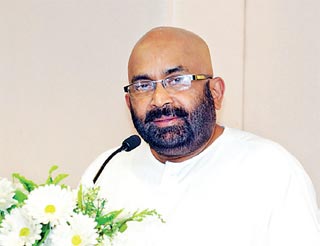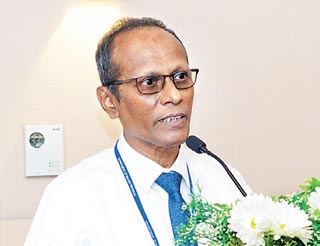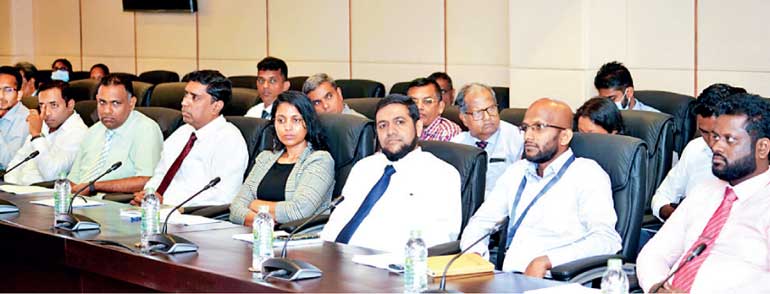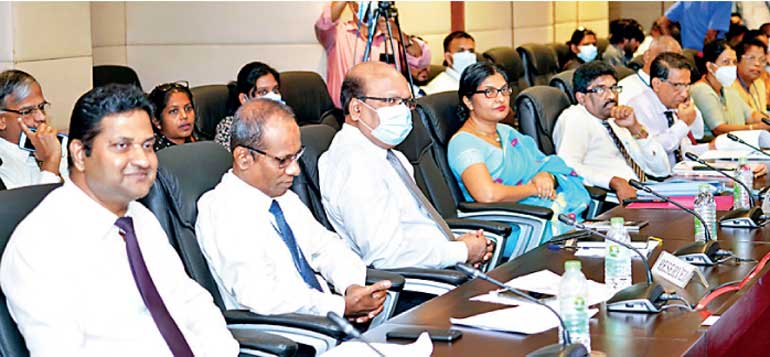Sunday Apr 27, 2025
Sunday Apr 27, 2025
Saturday, 24 December 2022 00:40 - - {{hitsCtrl.values.hits}}

State Minister of Finance Ranjith Siyambalapitiya

Treasury Secretary Mahinda Siriwardana

Inland Revenue Commissioner General Ranjith Hapuarachchi
The Government yesterday said it was ready to be flexible with suggestions and alternative ideas from taxpayers over the key challenge of boosting State revenue.
“The new tax policies introduced by the Government are implemented with the objective of saving the country from the worst financial crisis. However, these are policies and not like unchangeable inscriptions,” State Finance Minister Dr. Ranjith Siyambalapitiya said, inaugurating the ‘Diriya Pavura’ conference series.
The ‘Diriya Pavura’ conference series is organised by the Treasury in collaboration with the Inland Revenue Department to seek the views of the taxpayers. Yesterday’s conference was held for the taxpayers of the Colombo district and it is scheduled to be held covering all districts in the coming few weeks.
Treasury Secretary Mahinda Siriwardena, Department of Fiscal Policy Director-General Dr. Kapila Senanayake, Inland Revenue Department Director General D.R.S. Hapuarachchi, Heads of Departments belonging to the Ministry of Finance and a group representing the tax-paying business community of Colombo district joined the conference yesterday.
“We are starting this series of conferences to seek and listen to the responses and alternative proposals of the people who will pay taxes on the newly implemented policies. These are not inscriptions. The Government is ready at any moment to be flexible on the request of the taxpayers and reasonable proposals,” State Finance Minister said.
Sri Lanka became one of the lowest-income countries in the world in terms of GDP and was declared bankrupt after not being able to repay the debt, thus the country has no room to borrow more, he added.
Even against this backdrop, he noted that Sri Lanka still has over 3.4 million of 5.8 million families relying on Government handouts for a living, whilst 4.2 million children study in schools, another 200,000 children are studying in universities and 5.7 million people receive treatment at Government hospitals annually.
“There is no option left to finance social welfare, education, and healthcare. We cannot borrow any further. But, we cannot discontinue these public services. Therefore, the best option we have is to increase Government revenue via taxes. This new tax policy is made for that,” the State Minister said.
Government revenue in the first eight months of 2022 amounted to Rs. 1.27 trillion as against Rs. 942.5 billion in the corresponding period of 2021. Tax revenue rose from Rs. 853 billion to Rs. 1.12 trillion. Non-tax revenue rose to Rs. 147.5 billion from Rs. 89.4 billion.
As per the medium term fiscal stabilisation program, the Government aims for a revenue goal of 15% of GDP by 2025 from the 8.3% GDP as at end of 2021.
In 2023 the Budget targets a tax revenue of Rs. 3.13 trillion (up by 69%) within a total revenue of Rs. 3.4 trillion (up 63.5%) from 2022.
According to KPMG, the Government revenue as a % of GDP has dropped significantly, since recording its highest figure in the last decade (2011 – 2021) of 13.2% in 2016, to 8.3% in 2021.
In 2021 total Government revenue was Rs. 1.4 trillion out of which Tax revenue contributes for Rs. 1.2 trillion. Within Tax revenue, tax collected from direct sources accounted for 23.0% whilst indirect tax sources accounted for 77.0%.
In November the Government revised estimates for 2022 with tax revenue to be Rs. 1.85 trillion and non-tax revenue of Rs. 232 billion bringing the total revenue to Rs. 2.08 trillion.


Discover Kapruka, the leading online shopping platform in Sri Lanka, where you can conveniently send Gifts and Flowers to your loved ones for any event including Valentine ’s Day. Explore a wide range of popular Shopping Categories on Kapruka, including Toys, Groceries, Electronics, Birthday Cakes, Fruits, Chocolates, Flower Bouquets, Clothing, Watches, Lingerie, Gift Sets and Jewellery. Also if you’re interested in selling with Kapruka, Partner Central by Kapruka is the best solution to start with. Moreover, through Kapruka Global Shop, you can also enjoy the convenience of purchasing products from renowned platforms like Amazon and eBay and have them delivered to Sri Lanka.
Discover Kapruka, the leading online shopping platform in Sri Lanka, where you can conveniently send Gifts and Flowers to your loved ones for any event including Valentine ’s Day. Explore a wide range of popular Shopping Categories on Kapruka, including Toys, Groceries, Electronics, Birthday Cakes, Fruits, Chocolates, Flower Bouquets, Clothing, Watches, Lingerie, Gift Sets and Jewellery. Also if you’re interested in selling with Kapruka, Partner Central by Kapruka is the best solution to start with. Moreover, through Kapruka Global Shop, you can also enjoy the convenience of purchasing products from renowned platforms like Amazon and eBay and have them delivered to Sri Lanka.